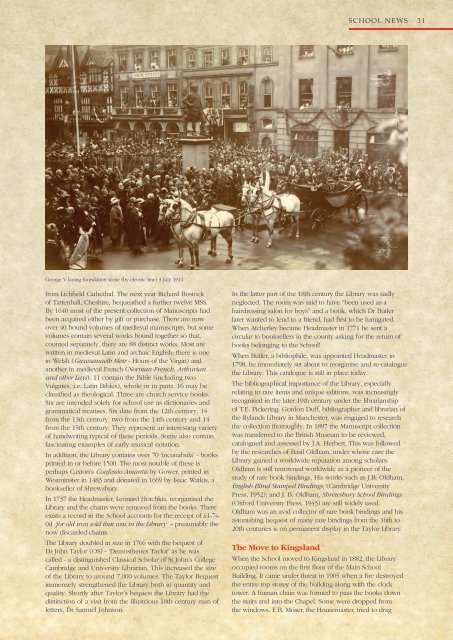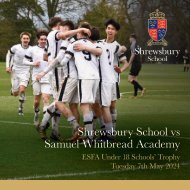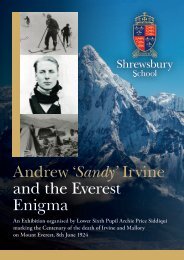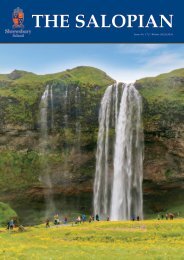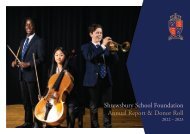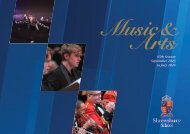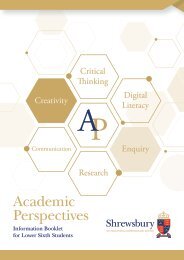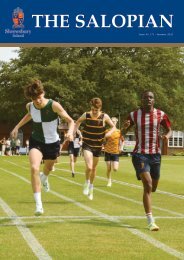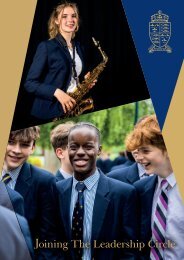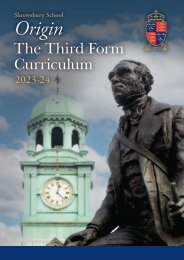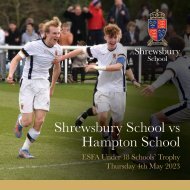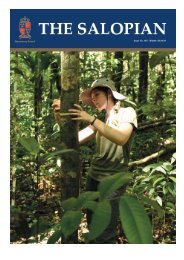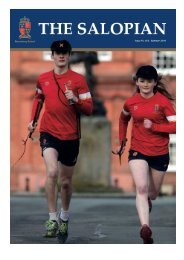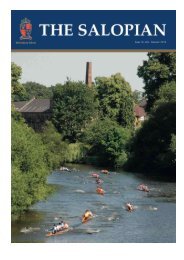The Salopian no. 160 - Summer 2017
- No tags were found...
Create successful ePaper yourself
Turn your PDF publications into a flip-book with our unique Google optimized e-Paper software.
SCHOOL NEWS 31<br />
George V laying foundation stone (by electric line) 3 July 1914<br />
from Lichfield Cathedral. <strong>The</strong> next year Richard Bostock<br />
of Tattenhall, Cheshire, bequeathed a further twelve MSS.<br />
By 1640 most of the present collection of Manuscripts had<br />
been acquired either by gift or purchase. <strong>The</strong>re are <strong>no</strong>w<br />
over 40 bound volumes of medieval manuscripts, but some<br />
volumes contain several works bound together so that,<br />
counted separately, there are 88 distinct works. Most are<br />
written in medieval Latin and archaic English; there is one<br />
in Welsh (Gwassanaeth Meir - Hours of the Virgin) and<br />
a<strong>no</strong>ther in medieval French (Norman-French, Arthurian<br />
and other Lays). 11 contain the Bible (including two<br />
Vulgates, i.e. Latin Bibles), whole or in parts. 16 may be<br />
classified as theological. Three are church service books.<br />
Six are intended solely for school use as dictionaries and<br />
grammatical treatises. Six date from the 12th century, 14<br />
from the 13th century, two from the 14th century and 14<br />
from the 15th century. <strong>The</strong>y represent an interesting variety<br />
of handwriting typical of these periods. Some also contain<br />
fascinating examples of early musical <strong>no</strong>tation.<br />
In addition, the Library contains over 70 ‘incunabula’ - books<br />
printed in or before 1500. <strong>The</strong> most <strong>no</strong>table of these is<br />
perhaps Caxton’s Confessio Amantis by Gower, printed in<br />
Westminster in 1483 and donated in 1669 by Isaac Watkis, a<br />
bookseller of Shrewsbury.<br />
In 1737 the Headmaster, Leonard Hotchkis, reorganised the<br />
Library and the chains were removed from the books. <strong>The</strong>re<br />
exists a record in the School accounts for the receipt of £1-7s-<br />
0d ‘for old iron sold that was in the Library’ – presumably the<br />
<strong>no</strong>w discarded chains.<br />
<strong>The</strong> Library doubled in size in 1766 with the bequest of<br />
Dr John Taylor (OS) - ‘Demosthenes Taylor’ as he was<br />
called - a distinguished Classical Scholar of St John’s College<br />
Cambridge and University Librarian. This increased the size<br />
of the Library to around 7,000 volumes. <strong>The</strong> Taylor Bequest<br />
immensely strengthened the Library both in quantity and<br />
quality. Shortly after Taylor’s bequest the Library had the<br />
distinction of a visit from the illustrious 18th century man of<br />
letters, Dr Samuel Johnson.<br />
In the latter part of the 18th century the Library was sadly<br />
neglected. <strong>The</strong> room was said to have “been used as a<br />
hairdressing salon for boys” and a book, which Dr Butler<br />
later wanted to lend to a friend, had first to be fumigated.<br />
When Atcherley became Headmaster in 1771 he sent a<br />
circular to booksellers in the county asking for the return of<br />
books belonging to the School!<br />
When Butler, a bibliophile, was appointed Headmaster in<br />
1798, he immediately set about to reorganise and re-catalogue<br />
the Library. This catalogue is still in place today.<br />
<strong>The</strong> bibliographical importance of the Library, especially<br />
relating to rare items and unique editions, was increasingly<br />
recognised in the later 19th century under the librarianship<br />
of T.E. Pickering. Gordon Duff, bibliographer and librarian of<br />
the Rylands Library in Manchester, was engaged to research<br />
the collection thoroughly. In 1897 the Manuscript collection<br />
was transferred to the British Museum to be reviewed,<br />
catalogued and assessed by J.A. Herbert. This was followed<br />
by the researches of Basil Oldham, under whose care the<br />
Library gained a worldwide reputation among scholars.<br />
Oldham is still re<strong>no</strong>wned worldwide as a pioneer of the<br />
study of rare book bindings. His works such as J.B. Oldham,<br />
English Blind Stamped Bindings, (Cambridge University<br />
Press, 1952); and J. B. Oldham, Shrewsbury School Bindings<br />
(Oxford University Press, 1943) are still widely used.<br />
Oldham was an avid collector of rare book bindings and his<br />
astonishing bequest of many rare bindings from the 16th to<br />
20th centuries is on permanent display in the Taylor Library.<br />
<strong>The</strong> Move to Kingsland<br />
When the School moved to Kingsland in 1882, the Library<br />
occupied rooms on the first floor of the Main School<br />
Building. It came under threat in 1905 when a fire destroyed<br />
the entire top storey of the building along with the clock<br />
tower. A human chain was formed to pass the books down<br />
the stairs and into the Chapel. Some were dropped from<br />
the windows. E.B. Moser, the Housemaster, tried to drag


